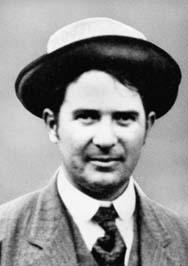Cheerleader facts for kids
Cheerleading is an exciting activity where participants, called cheerleaders, encourage their team. It can involve simple chants or complex physical routines. Cheerleading helps motivate sports teams, entertains audiences, and is also a competitive sport. Routines usually last one to three minutes. They include tumbling, dance, jumps, cheers, and stunts. Cheerleading started in the United States and has become a big tradition there.
Today, cheerleading is often seen with American football and basketball. Some other sports like soccer, ice hockey, volleyball, and baseball also have cheerleading squads. For example, the Miami Marlins were the first Major League Baseball team to have a cheerleading team. In 2007, the ICC Twenty20 Cricket World Cup in South Africa even featured cheerleaders for the first time in international cricket.
Cheerleading began as an activity mostly for boys in the United States. In 2017, about 3.85 million people participated in the U.S. The sport gained global attention with ESPN's international competition in 1997 and the movie Bring It On in 2000. The International Cheer Union (ICU) now has 116 member nations and about 7.5 million participants worldwide.
By the late 2000s, cheerleading grew in countries like Australia, Canada, Mexico, China, and Japan. In 2016, the International Olympic Committee (IOC) recognized the ICU. This means cheerleading is now considered a sport by the IOC. It could even become part of the Olympic Games in the future.
Contents
- History of Cheerleading
- Cheerleading Jumps
- Cheerleading Stunting
- Tumbling in Cheerleading
- Cheers, Chants and Sidelines
- Types of Cheerleading Teams in the United States
- Safety in Cheerleading
- Cheerleading Organizations and Competitions
- Cheerleading as a Recognized Sport
- Cheerleading in Canada
- Cheerleading in Mexico
- More About Cheerleading Around the World
- Notable Former Cheerleaders
- See also
- Images for kids
History of Cheerleading
Early Beginnings
In the 1860s, students in Great Britain started cheering together for their favorite athletes. This idea soon came to America. On November 6, 1869, the first college football game in the U.S. took place. Fans at this game between Princeton University and Rutgers University shouted the famous "Sis Boom Rah!" cheer.
Organized Cheerleading Starts
Organized cheerleading started with only boys. As early as 1877, Princeton University had a "Princeton Cheer." This cheer was yelled by students and athletes. Thomas Peebles, a Princeton graduate, brought the idea of organized cheering to the University of Minnesota in 1884.
The term "Cheer Leader" was used by 1897. Princeton's football officials named three students as cheer leaders. These students cheered for the team during practices and games.
In 1898, Johnny Campbell, a student at the University of Minnesota, led a crowd in a cheer. This made him the very first cheerleader. November 2, 1898, is known as the official start date of organized cheerleading. Soon after, the University of Minnesota formed a "yell leader" squad of six male students.
Girls Join Cheerleading
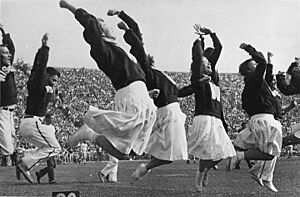
In 1923, girls were allowed to join cheerleading at the University of Minnesota. However, it took time for other schools to follow. By the 1940s, many college men were called to serve in World War II. This gave more opportunities for women to become cheerleaders at sporting events.
In 1949, Lawrence Herkimer, a former cheerleader, started his first cheerleading camp in Texas. It was very popular, with hundreds of girls attending. Herkimer also invented the pom-pom and the herkie jump.
Cheerleading Grows in Popularity (1950s-1970s)
In 1951, Herkimer created the National Cheerleaders Association (NCA). This helped cheerleading grow and provided training across the country. During the 1950s, more and more girls joined cheerleading. It became common in schools from elementary to college.
Professional cheerleading also began in the 1950s. The Baltimore Colts had the first recorded cheer squad in the National Football League (NFL). By the 1960s, NCA workshops taught cheer skills to thousands of high school girls.
In 1965, Fred Gastoff invented the vinyl pom-pom. Organized cheerleading competitions started to appear. The first "Top Ten College Cheerleading Squads" were ranked in 1967. The Dallas Cowboys Cheerleaders became famous in the 1970s for their dance routines. By 1975, over 500,000 students were cheerleaders in America, with most being girls. Competitive cheerleading was first shown on TV in 1978 on CBS.
Modern Cheerleading and Safety (1980s-Present)
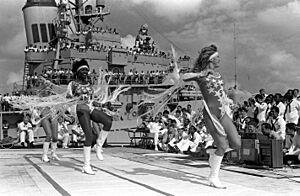
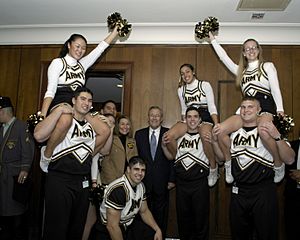
The 1980s brought modern cheerleading, with difficult stunts and gymnastics. "All-star" teams, not linked to schools, also started. The National High School Cheerleading Competition was first broadcast by ESPN in 1983.
Safety became a big focus. Organizations like the American Association of Cheerleading Coaches and Advisors (AACCA) created safety rules. These rules help prevent injuries from dangerous stunts and tumbling. College cheer coaches now need to complete safety training.
Cheerleaders are often seen as leaders in their schools. They help build school spirit and support other sports teams. In 2005, about 97% of cheerleaders were female. However, college cheerleading often has both boys and girls, with about 50% male participants. Male cheerleaders often focus on tumbling and strong stunts. In 2019, Napoleon Jinnies and Quinton Peron were the first male cheerleaders to perform at the Super Bowl.
Safety Rules for Stunts
Cheerleading involves exciting stunts, but safety is very important. After some serious accidents, rules were changed to make cheerleading safer. For example, in 2006, new rules restricted certain high-level stunts during basketball games. These stunts, like basket tosses and high pyramids, can now only be performed during halftime or after games on a matted surface. This helps protect cheerleaders from falls and other injuries.
Cheerleading Jumps
Jumps are exciting parts of cheerleading routines. Here are some common ones:
- Toe Touch: In this jump, a cheerleader spreads their legs wide and straight, parallel to the ground. Their toes point, and arms are in a "T" shape. Even though it's called a "toe touch," you don't actually touch your toes. This is the most common jump.
- Tuck: For this jump, the cheerleader pulls their legs up using their stomach muscles. Their thighs are parallel to the ground, and knees are together and pointing forward.
- Hurdler: One leg is straight, either forward (front hurdler) or to the side (side hurdler). The other leg is bent. Arms are usually in a "T" shape or a touchdown motion.
- Pike: This is one of the hardest jumps. Both legs are straight out in front, with knees locked. Arms reach forward to create a folded shape in the air.
- Around the World: Also called a pike-out. The cheerleader first performs a pike jump. Then, they quickly move their legs into a toe touch position while still in the air. This jump is very difficult because it requires two positions in a short time.
- Herkie: Named after Lawrence R. Herkimer, who founded the NCA. This jump is like a side hurdler. However, the arms are opposite to the legs. For example, the straight arm is on the side of the bent leg.
- Double Nine: Similar to a pike jump, but one leg and one arm are bent. This forms two shapes that look like the number "9."
- Double Hook: In this jump, both legs are bent into a "cheer sit" position.
- Double Jump: This means performing any jump twice in a row.
- Power Jump: For this jump, the cheerleader does not swing their arms to get power. All the power comes from their legs.
Cheerleading Stunting
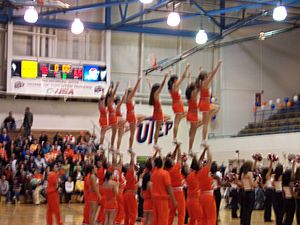
A stunt involves one to four people lifting or tossing a cheerleader into the air. In all-girl cheerleading, stunts usually have two to four people on the ground. In co-ed (partner) stunts, there is usually one male base and one female flyer.
Pyramids or mounts are when several stunts are connected in the air. This can be simple, like flyers holding hands. Or it can be complex, with flyers already in the air acting as bases for other flyers on top of them.
Positions in Stunting
- Flyers are the cheerleaders who are held or tossed into the air.
- Bases are the cheerleaders who hold and toss the flyers.
- Backspots stand behind the flyer and bases. They have three main jobs:
# To help prevent the stunt from falling and to catch the flyer if it does. # To help the bases by lifting some of the flyer's weight, making the stunt more stable. # To help the flyer safely get down from the stunt. Backspots often call out the stunt's start and end.
- Frontspots have similar jobs to backspots. They are often used by younger or less experienced teams.
Tumbling in Cheerleading
Tumbling involves gymnastic moves. The most basic tumbling skills are a roll, a cartwheel, or a round-off. Other basic but harder skills include back-handsprings and round-off back-handsprings.
More advanced tumbling skills include:
- Back tucks
- Layouts
- Arabians
- Whipbacks
- Twisting layouts (fulls)
- Front tumbling, such as front handsprings and punch fronts.
Cheers, Chants and Sidelines
Every cheerleading team has its own special cheers and chants. Often, the cheerleaders and coaches create these themselves.
- Cheers are usually longer than chants. They often include jumps, tumbling, or stunting. Cheers focus on supporting a mascot or team and getting the crowd to join in. Each word often has a specific motion.
- Chants are short and repeated. They are usually said three times. Chants often have simple motions that can be done while standing in a line or just by clapping to a beat.
- Sidelines are also usually repeated three times. They typically include motions.
Types of Cheerleading Teams in the United States
School-Sponsored Teams
Most middle schools, high schools, and colleges in America have cheerleading squads. Some colleges even offer scholarships for cheerleaders. These teams cheer for sports events and encourage the crowd. They might also compete locally or nationally.
Middle School Cheerleading
Middle school cheerleading teams support their school's sports teams. They also perform at pep rallies and sometimes compete. These teams use similar movements to older cheerleaders but may have simpler stunts and tumbling.
High School Cheerleading
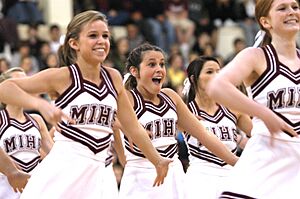
High schools usually have junior varsity and varsity squads. High school cheerleading combines school spirit with competition. Teams practice year-round, cheering for football and basketball games. They also perform at pep rallies. Many teams compete in regional and national competitions. In 2009, about 394,700 high school students were cheerleaders.
College Cheerleading
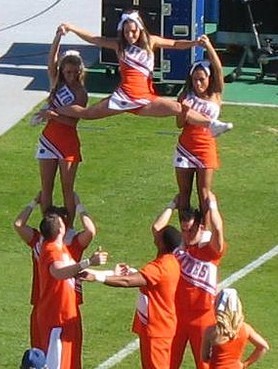
Most American universities have a cheerleading squad. They cheer for various sports like football, basketball, and volleyball. College teams often include both boys and girls and perform more difficult stunts. Many college teams also compete in national championships like UCA College Nationals. Winning these is a big achievement for a university.
Youth League Cheerleading
Youth cheer teams are often part of organizations that also sponsor youth football or basketball. The cheerleaders support these teams at games. Some youth teams also compete in local or regional events. The Pop Warner Association even has a national championship for its cheer teams.
All-Star or Club Cheerleading
"All-star" or club cheerleading is different because these teams focus only on competition. They don't cheer for other sports teams. All-star cheerleaders belong to private gyms or clubs.
All-star teams started in the 1980s. The first all-star organization was the Q94 Rockers in 1982. To make rules consistent and improve safety, the U.S. All Star Federation (USASF) was formed in 2003. It became the main group for all-star cheerleading in the U.S. The International All-Star Federation (IASF) now guides club cheerleading worldwide.
All-star teams have 5 to 36 members, both boys and girls. They are grouped by age, team size, gender, and skill level. Teams practice all year for competitions. Their routines are about 2.5 minutes long and include stunts, tumbling, jumps, and dance. Judges look for difficulty, execution, synchronization, and creativity. The Cheerleading Worlds competition, held at Walt Disney World, is the highest level for elite all-star teams.
Professional Cheerleading
Professional cheerleaders and dancers cheer for sports like football, basketball, and baseball. Some professional leagues include the NBA Cheerleading League and the NFL Cheerleading League. These cheerleaders often do charity work, modeling, and TV performances in addition to cheering at games.
Safety in Cheerleading
Cheerleading is a fun and athletic activity, but it's important to be aware of safety. Most serious injuries in cheerleading happen during stunting, also known as pyramids. These stunts involve a "flyer" (the person on top), "bases" (people on the bottom), and "spotters" (people who help prevent falls).
The most common cheerleading injury is a concussion. Other injuries can include sprains, strains, and sometimes broken bones. Safety rules and proper training are very important to prevent these injuries. Organizations like the American Association of Cheerleading Coaches and Advisors (AACCA) work to create safety standards. These standards help ensure that cheerleaders learn and perform stunts safely.
Cheerleading Organizations and Competitions
International Cheer Union (ICU)
The ICU was created in 2004. It is recognized as the world's main organization for cheerleading. The ICU has 105 member countries and millions of athletes. It works to develop cheerleading positively around the world. The ICU holds training for judges and coaches, global events, and the World Cheerleading Championships. It also works with the International Olympic Committee (IOC) and follows anti-doping rules.
USA Cheer
USA Cheer was formed in 2007. It is the national organization for all types of cheerleading in the United States. USA Cheer helps grow the sport, promotes safety education, and represents the U.S. in international competitions. They also organize the USA National Team.
Major Competitions
Many different competitions are held for cheerleading teams.
- ICU World Championships: Countries send one team to represent them at this competition. Teams perform routines in a collegiate style.
- USASF/IASF Worlds: This competition is for All-Star/Club cheer teams. It takes place at Walt Disney World and teams must qualify to attend.
- Varsity Spirit: This is a large company that organizes many cheerleading competitions across the U.S. and internationally. They own many smaller competition brands.
Competitions are judged on how difficult and well-executed the jumps, stunts, and tumbling are. Judges also look at synchronization, creativity, and overall performance. Winning a world championship title is a huge honor for cheerleaders.
Cheerleading as a Recognized Sport
In the United States, there's a discussion about whether cheerleading should be officially recognized as a "sport." This is important because of Title IX, a law that ensures equal opportunities for boys and girls in education programs, including sports.
Some people believe cheerleading is a sport because it requires great athletic talent. Others see it as a physical activity because not all cheerleading squads compete. Also, judging in cheerleading can be subjective, like in gymnastics or figure skating.
The National Collegiate Athletic Association (NCAA) does not currently recognize cheerleading as a sport. However, the American Medical Association adopted a policy in 2014 suggesting cheerleading should be considered a sport due to the high level of physical activity and potential for serious injuries. This recognition could help teams get better funding and offer more scholarships.
Cheerleading in Canada
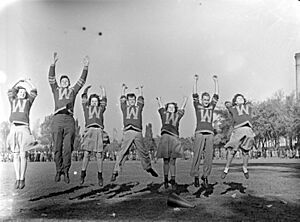
Cheerleading is becoming very popular among young people in Canada. It has grown from just cheering on the sidelines to a competitive activity. Cheerleading is available at middle school, high school, college, and in all-star clubs. There are many regional, provincial, and national championships for athletes.
Cheer Canada is the national organization for cheerleading in Canada. They work with provincial organizations to govern the sport. Canada also has a national team, called Team Canada, which competes at the ICU World Cheerleading Championships. In 2023, Team Canada won 4 medals (1 gold and 3 silver) at the ICU World Championships.
Cheerleading in Mexico
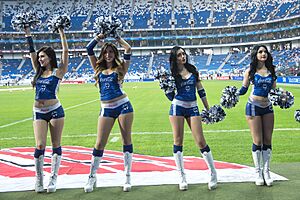
Cheerleading is a popular sport in Mexico. It is often seen at Mexican College Football and Professional Mexican Soccer games. Cheerleading started at the National Autonomous University of Mexico (UNAM) in the 1930s. Since then, it has grown across the country.
The Mexican Federation of Cheerleaders and Cheerleading Groups (FMPGA) oversees competitions in Mexico. In 2015, the Mexican national team won first place at the ICU World Cheerleading Championship, earning a gold medal. Mexico is considered a strong country in cheerleading, having won many medals in international competitions.
More About Cheerleading Around the World
- Cheerleading in the United Kingdom
- Cheerleading in Australia
Notable Former Cheerleaders
- List of cheerleaders
See also
 In Spanish: Animación (deporte) para niños
In Spanish: Animación (deporte) para niños
- Basket toss
- Cheerleader Nation
- Cheerleader effect
- Cheerleading in Japan
- Cheerleading Philippines
- Color guard
- Dance squad
- List of cheerleading jumps
- List of cheerleading stunts
- Majorette (dancer)
- National Basketball Association Cheerleading
- National Football League Cheerleading
- Pep squad
- Pom-pom
- UAAP Cheerdance Competition
- Varsity Brands
Images for kids


